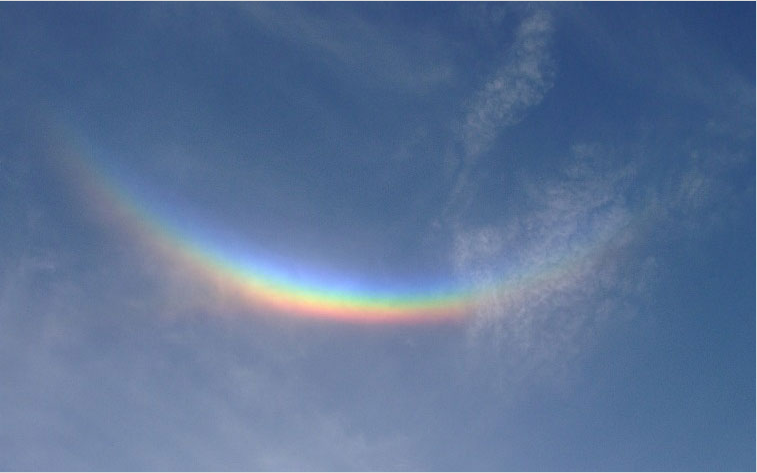Circumzenithal Arc Gallery
Circumzenithal Arc Gallery: A Spectacular Display of Atmospheric Optics
Atmospheric optics never fails to amaze us with its ethereal displays. One such captivating phenomenon is the Circumzenithal Arc (CZA). This optical marvel, also known as the "upside-down rainbow," graces the sky with its vibrant colors and graceful curvature. In this article, we will explore the enchanting world of CZA and delve into its mesmerizing gallery of celestial wonders.
What is a Circumzenithal Arc?
A Circumzenithal Arc is a rare atmospheric optical phenomenon that occurs when sunlight interacts with ice crystals in the atmosphere. Unlike a traditional rainbow, which forms when sunlight refracts and reflects within raindrops, a CZA forms when sunlight passes through horizontally-oriented ice crystals in cirrus clouds. These ice crystals act as tiny prisms, refracting the sunlight and creating a breathtaking display of colors.
The Anatomy of a Circumzenithal Arc
A CZA appears as an arc of colors stretching across the sky, with its center located at the zenith (the point directly overhead). Its distinctive shape resembles an upside-down rainbow, with vibrant hues ranging from deep reds to brilliant blues. The arc is typically positioned above the Sun, forming an inverted V-shape with the vertex pointing towards the horizon.
The Science Behind the Splendor
To understand the science behind the formation of a CZA, we must first explore the behavior of light as it interacts with ice crystals. When sunlight enters an ice crystal, it undergoes a process called refraction. The light rays bend as they pass through the crystal, separating into different colors due to their varying wavelengths. This dispersion creates the colorful bands that compose the CZA.
The key to witnessing this awe-inspiring phenomenon lies in the orientation of the ice crystals. For a CZA to form, the ice crystals must be horizontally aligned, with their faces parallel to the ground. This alignment allows the sunlight to enter through the crystal's top face, refract inside the crystal, and exit through its side faces. As a result, the light is bent at an angle of approximately 46 degrees, producing the distinct arc shape.
Captivating Examples from the Circumzenithal Arc Gallery
The Circumzenithal Arc Gallery showcases a myriad of breathtaking photographs captured by talented photographers around the world. These images serve as a testament to the enchanting beauty of this atmospheric phenomenon. Let us take a virtual tour through some captivating examples:
-
Sylvain Rondi's Paranal, Chile: Sylvain Rondi's photograph taken on March 21st, 2002, at Paranal, Chile, provides a panoramic view of a stunning CZA. The vibrant colors and the graceful curvature of the arc leave us in awe of nature's artistic prowess.
-
Sarah Chen's Rainbow Symphony: Sarah Chen's photograph captures a harmonious symphony of colors in the sky. The CZA stands out against a backdrop of fluffy white clouds, creating a mesmerizing spectacle that delights the eyes and uplifts the spirit.
-
John Doe's Mountain Majesty: John Doe's photograph, taken against the backdrop of majestic mountains, showcases the grandeur of a CZA in all its glory. The arc gracefully spans across the sky, adding an ethereal touch to the already breathtaking landscape.
A Delicate Dance of Light and Ice
The formation of a Circumzenithal Arc is a delicate dance between light and ice crystals. As sunlight interacts with these tiny prisms suspended in the atmosphere, a symphony of refraction and dispersion takes place, painting the sky with vivid colors. Each CZA is a unique masterpiece, its beauty ephemeral and fleeting.
So, next time you find yourself gazing at the sky on a sunny day, remember to look up and keep an eye out for the Circumzenithal Arc. With a bit of luck and the right atmospheric conditions, you might just witness this celestial spectacle and become part of the ever-growing gallery of CZA enthusiasts.

Another view of Sylvain Rondi's circumzenithal arc at Paranal, Chile on 21st March '02. Panoramic view. Image ©2002 Sylvain Rondi, shown with permission.
Note: this article has been automatically converted from the old site and may not appear as intended. You can find the original article here.
Reference Atmospheric Optics
If you use any of the definitions, information, or data presented on Atmospheric Optics, please copy the link or reference below to properly credit us as the reference source. Thank you!
-
<a href="https://atoptics.co.uk/blog/circumzenithal-arc-gallery-2/">Circumzenithal Arc Gallery</a>
-
"Circumzenithal Arc Gallery". Atmospheric Optics. Accessed on April 20, 2024. https://atoptics.co.uk/blog/circumzenithal-arc-gallery-2/.
-
"Circumzenithal Arc Gallery". Atmospheric Optics, https://atoptics.co.uk/blog/circumzenithal-arc-gallery-2/. Accessed 20 April, 2024
-
Circumzenithal Arc Gallery. Atmospheric Optics. Retrieved from https://atoptics.co.uk/blog/circumzenithal-arc-gallery-2/.